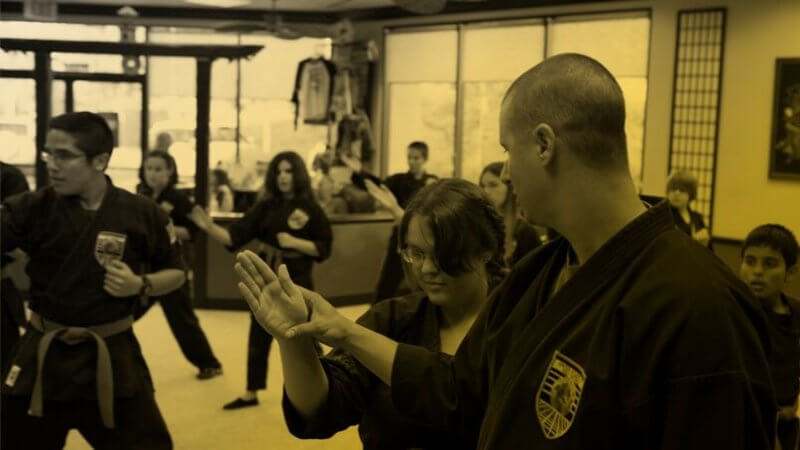Martial Arts Instructor Training: How to Use Influence Over Authority


Have you heard of the concept influence versus authority? It’s an excellent tool for teachers based on the foundation of using your influence instead of your authority to motivate students. While using your authority may have an instant response, it is often short-lived and you typically face similar or new problems. Teaching through influence may take longer, but it will definitely have a lasting impact on your students.
Authority uses discipline, but your influence develops self-discipline among your students. So, how do we use our influence versus authority?
1). Start With Heart
Maya Angelou said, “People will forget what you said, they forget what you did, but they will never forget the way you made them feel.”
Your students must feel like you truly care about them. To ensure your students understand that you care, ask yourself the following questions:
- Do you know what’s going on in their lives?
- Are you invested in their goals, hopes and dreams?
- Do you help them set realistic goals and hold them accountable when they fall off track?
- Do you use your students’ names and make eye contact when speaking?
Work hard to show your students how much you value each and every one of them. As Zig Ziglar once said, imagine that everyone you’re speaking with has a shirt on that reads, “make me feel important.”
2). Quality communication
Remember to audit the quality of your communication. When we think of what this means, we break it into the following categories:
- Body language
- Facial expression
- Word choice
- Tonality
This will vary greatly depending on what class you’re teaching, as well as who you’re teaching. With a class of four-year-olds, you need to be more animated and a bit exaggerated. However, if you spoke that way to your adult students, it would be demeaning.
Next, you need to look at the words you’re using. Is there a positive spin on them? Here’s a great example:
- “Don’t drop your hands, Tyler!”
- Or a better version, “Tyler, make sure to keep your guard up!”
They both have the same meaning, but are delivered differently. What about your tone of voice? Remember Ben Stein in Ferris Bueller’s Day Off? Is there fluctuation in your pitch, volume and speed that you speak? If you routinely catch students looking up at the clock, try recording yourself teaching and watch it later to see how you can improve in this area.
3). Spotlighting
It is beneficial to all of your students highlight correct behavior and expectations throughout class. Here’s an example, “Everyone break for a second. I want to highlight Paula over here for an exceptional jab-cross. Watch her jab-cross for a second! See how she really rotates her hips, and drops her weight? Nice job, Paula!”
Spotlighting does many things. It reinforces the expectations you have for your students. It makes other students want public praise from you as well, therefore reinforcing what you are looking for from them. Most importantly, it makes the person you’re spotlighting feel great!
4). Proximity Praise
Proximity praise starts when you identify one student making a mistake, either technique or behavior-wise. Look for another student within proximity who is performing the move correctly, and praise them. Ideally, the other student doing it wrong will want that positive acknowledgment too and correct their form or behavior. Once the original student makes the correction you are looking for, go over and praise them. This is a disguised, but effective way of correcting. You’re getting the student to want to make the correction on their own, versus just doing it because you said so.
5). Praises and Corrections
Famous NBA Coach, Phil Jackson, talks about the magic ratio of five praises for every one critique. You want to look for the good in your students and catch them doing something right. Don’t give false praise, but if you look hard enough you can find something right. For instance, when one of your students is doing a lot of things wrong but they’re trying hard, you be sure to praise them for their continued effort.
I hope you found these strategies useful! Make it a goal each class you teach to use you influence instead of authority. Just like an actor is only is good as their last movie, we are only as good as our last class. For more tips on becoming a better instructor, learn more about The Satori Alliance Instructor Certification Program.
Interested in learning what types of classes the most successful martial arts schools are offering? Get your copy of our Martial Arts Benchmark Report.
Guest post written by Nick Wilson, The Satori Alliance![nick wilson[1]](https://zenplanner.com/uploads/nick-wilson1-272x300.png)
Nick Wilson has been training in martial arts for 27 years, and teaching for 20 years under Kyoshi Dave Kovar in Sacramento, CA. He holds Black Belts in Kenpo, Brazilian Jiu-jitsu, Doce Pares Eskrima and Tae Kwon Do. He’s managed three different Kovar’s Martial Arts locations, the biggest one with 385 students. He currently is the General Manager for The Satori Alliance, which is dedicated to raising the standard for professional martial arts instruction for 73 Member Schools Internationally.

I’m Coach Kelli, a devoted CrossFit gym owner with 15 years of experience managing my facility, along with owning yoga studios and wellness centers. Beyond the fitness world, I have a passion for cooking, cherish moments with my children and family, and find joy in spending time outside. Having experienced the highs and lows, I’m dedicated to leveraging my expertise to help you grow and succeed on your fitness journey.

I’m Coach Kelli, a devoted CrossFit gym owner with 15 years of experience managing my facility, along with owning yoga studios and wellness centers. Beyond the fitness world, I have a passion for cooking, cherish moments with my children and family, and find joy in spending time outside. Having experienced the highs and lows, I’m dedicated to leveraging my expertise to help you grow and succeed on your fitness journey.








